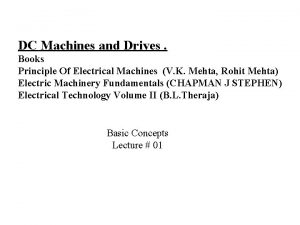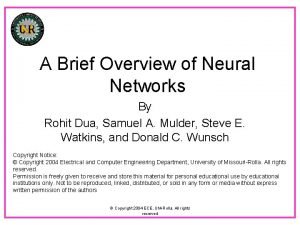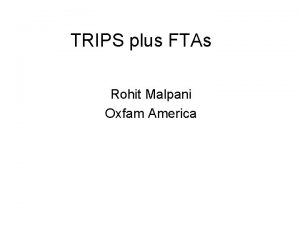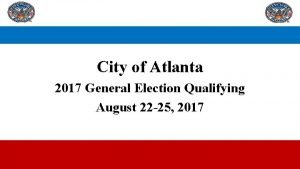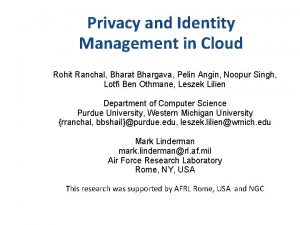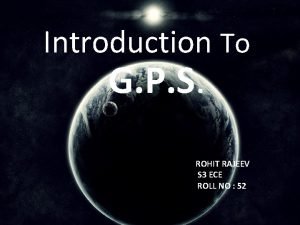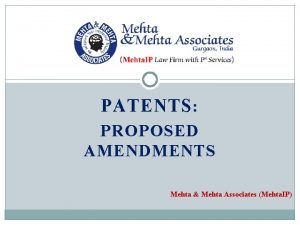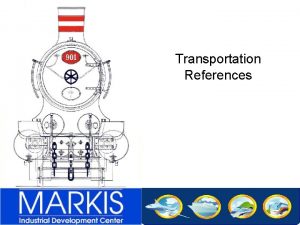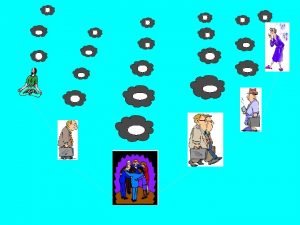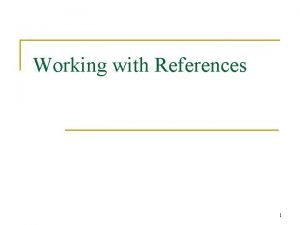REFERENCES 1 V K Mehta Rohit Mehta Principles







- Slides: 7


REFERENCES 1 - V. K Mehta, Rohit Mehta “Principles of Electrical Machines, First Edition”, S. Chand & Company Limited, 2002. (Chapters 10&11) 2 - B. L. Theraja, A. K. Theraja, “Electrical Technology, Twenty-third Edition”, Mc. Graw. Hill, 2005. (Volume II (AC & DC Machines, Chapters 37 & 38) 3 - Stephen J. Chapman, “Electric Machinery Fundamentals, Fifth Edition”, Mc. Graw. Hill, 2012. (Chapters 4&5) 4 - E. Fitzgerald, Charles Kingsley, Jr. and Stephen D. Umans, “Electric Machinery, Sixth Edition”, Mc. Graw-Hill, 2003. (Chapter 5) 2

Synchronous Machines This chapter includes forty one topics, which are: Synchronous Generators 1. Introduction 2. Types Of Synchronous Machines 3. Construction of Alternator 4. Speed and Frequency 5. Alternator Operation 6. E. M. F. Equation of an Alternator 7. Armature Reaction in Alternator 8. Equivalent Circuit of Cylindrical-Rotor Machines 9. Phasor Diagrams of Unsaturated Cylindrical-Rotor Type 3

10. Synchronous Machine Characteristics 10. 1 Open Circuit Characteristic (O. C. C) 10. 2 Short Circuit Characteristic (S. C. C) 10. 3 Zero-Power-Factor Characteristic (Z. P. F. C) 11. Voltage Regulation 11. 1 The Synchronous Impedance Method 11. 2 Rothert’s M. M. F or Ampere Turn Method 11. 3 Zero Power Factor Method (Potier Method) 12. Operation of a Salient Pole Synchronous Machine 13. Effect of Salient Poles 14. Two-Reactance Concept for Salient-Pole Machines 15. Power and Torque in Cylindrical-Rotor Machines 16. Power and Torque in Salient-Pole Machines 17. Power angle characteristic 4

18. Parallel Operation of Alternators 18. 1 Advantages of Parallel Operation of Alternators 18. 2 Conditions for Paralleling Alternator with Infinite Busbars 18. 3 Methods of Synchronization 19. Synchronizing Action (i) Effect of speed change (ii) Effect of inequality of e. m. f. s. 20. Synchronizing Power and Torque of Synchronous Machines 21. Effect of Load on Synchronizing Power 22. Sharing of Load Currents by Two Alternators in Parallel 23. Alternator on Infinite Busbars (Distribution of Load) (a) Effect of Change in Excitation (b) Effect of Change in Steam Supply 5

Synchronous Motors 24. Introduction 25. Construction 26. Operating Principle 27. Making Synchronous Motor Self-Starting 28. Equivalent Circuit 29. Motor on Load 30. Pull-Out Torque 31. Motor Phasor Diagram 32. Effect of Changing Field Excitation at Constant Load 33. Phasor Diagrams With Different Excitations 34. Power Relations 6

35. Motor Torque 36. Mechanical Power Developed By Motor 37. Power Factor of Synchronous Motors 38. Synchronous Condenser 39. Applications of Synchronous Motors 40. Steady-State Operating Characteristics 40. 1 Load Characteristics 40. 2 Field Compounding Characteristics 40. 3 V-Curves of Synchronous Motor 41. Comparison of Synchronous and Induction Motors 7
